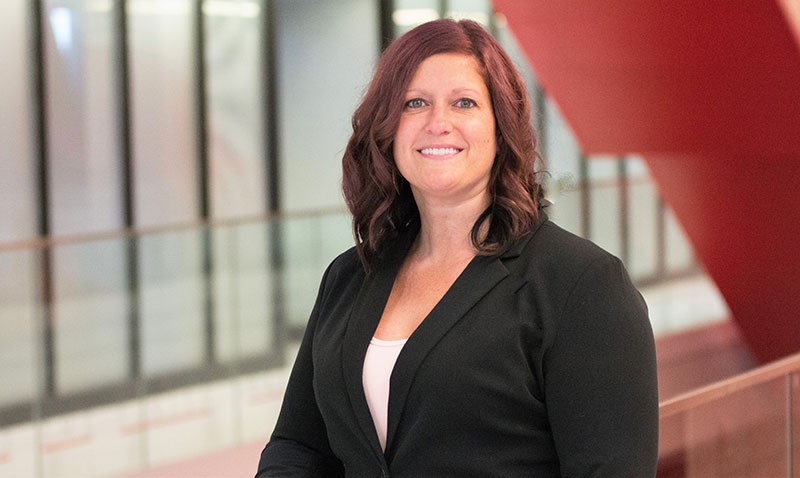Universal design for learning and accessibility are key players for new eLearning Champion

Jennifer Sturm, Academic Specialist and Assistant Director of Learning Services for student athletes, is this month's eLearning Champion.
One of the challenges professors face is figuring out how to accommodate all the different ways students learn. Old models of teaching are being replaced by modern techniques to reach students of every learning style. What works best for one student may not work best for another, so the challenge lies in making the same material easily accessible to different students in the same classroom.
Jennifer Sturm, University of Cincinnati academic specialist and assistant director of learning services for student athletes, was part of a program called Universal Design for Learning Faculty Community Experience during the 2016-17 academic year.
This program is focused on presenting material to students in a variety of ways that recognize the differences in learning styles among them. The program taught Sturm not to make assumptions in regard to student learning. She then took what she learned and applied it to her classroom practically through the use of different technological tools.
Sturm, who teaches a college success skills class in the summer for incoming freshman athletes as well as sport pscyhology in the fall and spring semesters, was part of a pilot program for a Blackboard add-on tool called Ally, which manages content accessibility. As a professor uploads a document to Blackboard, the Ally tool will tell them how accessible that content is to different devices. Students then have the option to download the content in a different format than the way it was uploaded.
"Lets say I uploaded a PDF file," Sturm said. "Students had an option of looking at the PDF or listening to an MP3 file, which is a really cool option. So students with learning disabilities but also students who learn differently maybe a student who learns better auditorily could access the file."
Sturm's area is also part of an iPad pilot program in which student athletes are given iPads to assist with her class.
"I was able to utilize both Canopy tools and iPad tools in the classroom experience. Everything that was required of the students outside of class, they did it through Blackboard," Sturm said.
For class materials and assignments, Sturm utilized the UC Box file sharing service as well as iTunes U.
"One of the main goals for my class is to teach students the skills they need to be successful in college. And one of the biggest ones is organization. By using iTunes U, and also utilizing Box as the file-saving cloud space, they were much more organized. Instead of shuffling through their backpack, they knew [their materials] were either in Box or iTunes U," she said.
Prior to the Universal Design for Learning program, Sturm was still ahead of the curve on using tech in the classroom. A few years ago, Sturm switched to the flipped classroom model, uploading video lectures through Kaltura for students to watch before class. While in class, students took a comprehension quiz through Blackboard to verify that they watched the lectures before diving deeper into the material. Sturm even improved the convenience of the video lectures by adding closed captioning for students who appreciate the words appearing on screen.
The flipped classroom model provided flexibility to the students learning experience. Sturm says the difference in student engagement compared to the years before the flipped classroom was noticeable.
"I was doing the lecture in class and that would limit the amount of interaction and digestion of the material that we could do," she said.
To limit the use of paper, simplify grading and make life easier for students, Sturm increasingly has incorporated Blackboard into her classes. In her class Psychology of Sport, which applies psychological concepts to sports, she uses Blackboards quiz and discussion board functions. In previous years, she would conduct quizzes and assignments in paper and pencil format. Upon converting to Blackboard, Sturm noticed several advantages: not only do students get feedback right away but also Blackboard reduced grading time, allowing her to focus more on the in-class experience.
In addition to the Universal Design for Learning program, Sturm has also been a part of the Lightening Lessons in the Active Learning Classroom Course Design Institute and the Active Learning Course Design institute. She continues to use what she learned from these experiences to provide students with variety in the classroom through creative use of new technology to accommodate learning differences.
An eLearning Champion is someone who exemplifies the use and integration of UC's eLearning tools and resources in the classroom. Nominate someone to be an eLearning Champion!
To learn more about instructional design, accessibility, classroom technology, Canopy tools and more, meet one-on-one with CEeL team members to discuss ways to enhance their students experience at:
Canopy Creative Space
Fridays from 9-11 a.m. in 480 Langsam Library (CET&L)
or via WebEx: https://bit.ly/2l6c97r
Meeting number (access code): 642 621 178
Meeting password: Scowl3r
JOIN BY PHONE +1-415-655-0002 US Toll
Related Stories
UC architectural engineering alumna inspires high school students
April 16, 2024
University of Cincinnati alumna Emma Wilhelmus fell in love with engineering when she was in ninth grade. After taking drafting, architecture and engineering courses in high school, she set out to major in architectural engineering in college. Now, she is an engineering teacher at a local high school and hopes to inspire students.
UC Clermont to host Rapid Application Events
April 16, 2024
The University of Cincinnati Clermont College will hold four free Rapid Application Events on campus during May and June.
Warren Bennis Leadership Summit spotlights leadership theory,...
April 16, 2024
The inaugural Warren Bennis Leadership Institute Summit invited regional business leaders to hear from and engage with UC alumni, executives and thought leaders on April 8 at the 1819 Innovation Hub.
